Rennie Scaysbrook | September 28, 2023
The bike that started the maxi-ADV segment will come in for a complete overhaul for the 2024 model year as BMW unleashes the R 1300 GS.
The new 1300 takes over from the R 1250 GS, one of our favorite bikes here at Cycle News, but rather than just be a nip and tuck like the 1250 was to the 1200 six years ago, the 1300 is a ground-up job that will no doubt have some polarizing views about it. There’s a new motor, frame, electronics including radar-assisted cruise control and blind spot detection, front collision warning, 6.5-inch TFT dash, the list goes on. And on.
Starting at $18,895 MSRP, scheduled to arrive in early 2024, and available in the base mode, GS Trophy, Triple Black, or the green Option 719 Tramuntana, the BMW R 1300 is a claimed 26 lb lighter than the old 1250. Under the hood sits a new flat-twin pumping out 145 hp at 7750 rpm and 110 lb-ft of torque at 6500 rpm, and utilizing BMW’s long-held ShiftCam variable valve timing system, making it the most powerful boxer motor to come from BMW.
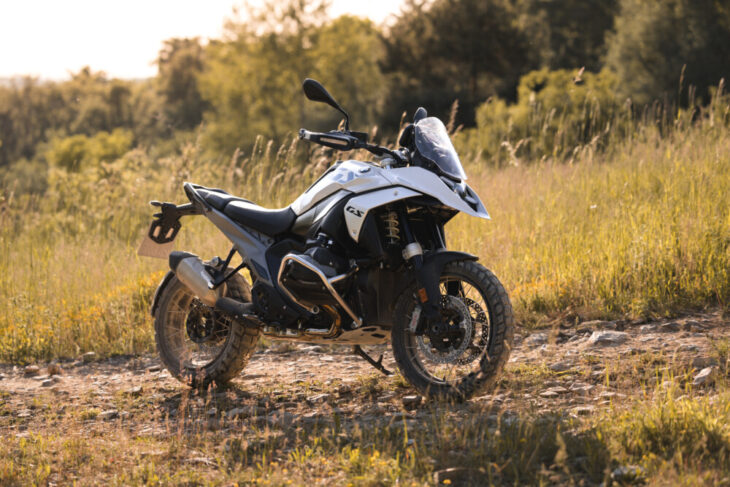 Pretty different, hey? The new GS will be a definite talking point in the maxi-ADV segment next year.
Pretty different, hey? The new GS will be a definite talking point in the maxi-ADV segment next year.
Measuring an exact 1300cc via 106.5 x 73 mm dimensions (the R 1250 GS measured 102.5 mm and 76 mm for 1254cc), BMW claims 96 of those 110 lb-ft of torque is available from 3600-7800 rpm, right where riders will spend the majority of their time.
BMW has reconfigured the motor to run the gearbox underneath rather than behind the crankshaft, making for a far more compact design than the 1250, while also saving a claimed 8.6 lb for the gearbox and 14.3 lb overall for the powertrain. The gearbox now has a sensor signal transmitter for the optional Shift Assistant Pro using a torsion magnet that delivers a more direct feel when shifting gears.
As mentioned, the ShiftCam system returns for the 1300 that varies the valve timing and valve stroke on the intake side. The system runs a single-section intake shift camshaft which has a partial-load and a full-load cam for each valve to be actuated, each with a different cam geometry.
The intake cams for the left and right-hand intake valves of the partial-load cam differ in stroke and position. This phase shift means that the two intake valves are opened to different degrees and on a time-staggered (rpm) basis.
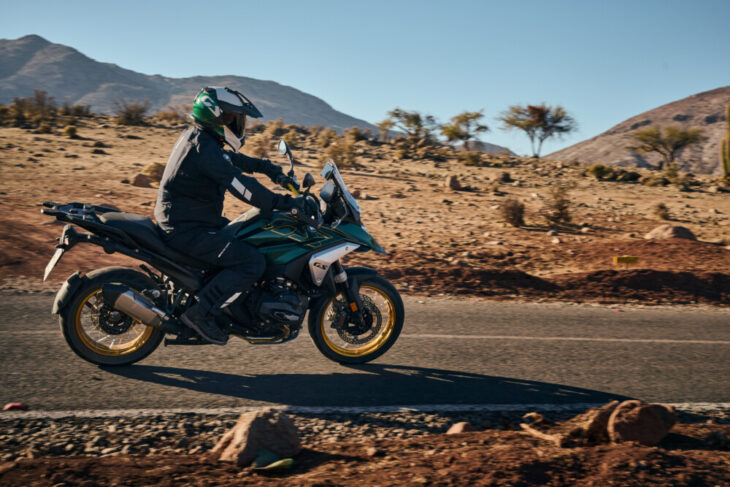 The GS in Option 719 Tramuntana green looks fetching.
The GS in Option 719 Tramuntana green looks fetching.
The motor benefits from four standard riding modes in Rain, Road, Enduro and the Eco mode that maximizes fuel range. Riding Modes Pro returns as you’d expect which offers more customization for traction control and offers Dynamic, Dynamic Pro and Enduro Pro, and you can have different configurations for quicker access to your preferred modes so you don’t get lost in the matrix, such as Dynamic and Dynamic Pro for the road and Enduro and Enduro Pro for off-road.
Engine drag torque control (MSR) is standard, but gets switched off in Enduro Pro mode to allow you to drift into corners on the dirt.
The frame gets a complete overhaul as well. Eagle-eyed readers will easily spot the new subframe, a cast aluminum unit over the traditional tubular steel design. The main frame is constructed with steel sheet metal, offering higher stiffness and better road holding than the outgoing frame on the 1250.
The trademark Telelever suspension has been reworked, as has the Paralever rear suspension.
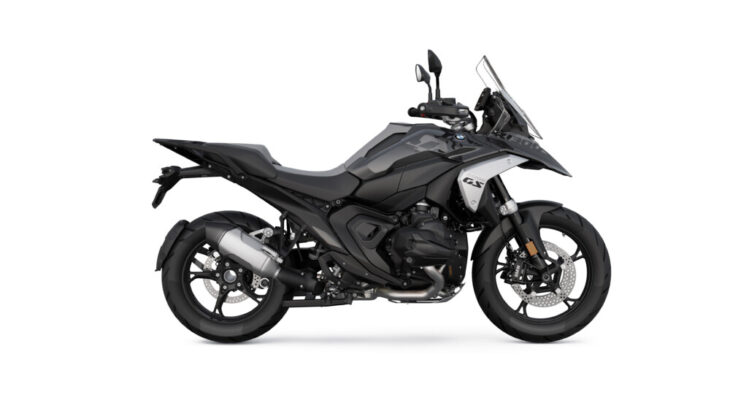 The new GS in Triple Black option.
The new GS in Triple Black option.
Dubbed the EVO Telelever, the new system takes lessons learned with the stiffly-connected R 1200 S and HP2 Sport, as well as the more loosely mounted units of previous GS models to create what BMW calls is the best of both worlds.
The Telelever is tightly clamped to the forks as before, and the upper fork construction incorporates a handlebar decoupling system that prevents any unwanted tilting movement and only transmits steering forces.
The actual upper fork bridge is pivotally and rotatably connected via a radial swivel bearing to a sturdy steering shaft tube, which in turn is guided in the main frame via a cylindrical roller bearing at the top and a deep groove ball bearing at the bottom, which significantly aids steering rigidity.
the Paralever rear suspension benefits from a longer swingarm, a stiffer connection to the frame, while the swingarm bearing is arranged off-axis to the axis of rotation of the cardan shaft joint.
Perhaps bigger than the hardware changes for the suspension is the new optional Dynamic Suspension Adjustment, which now adjusts spring rate on the fly in a similar style to the top-line Ohlins units found on the Ducati Multistrada V4 platform.
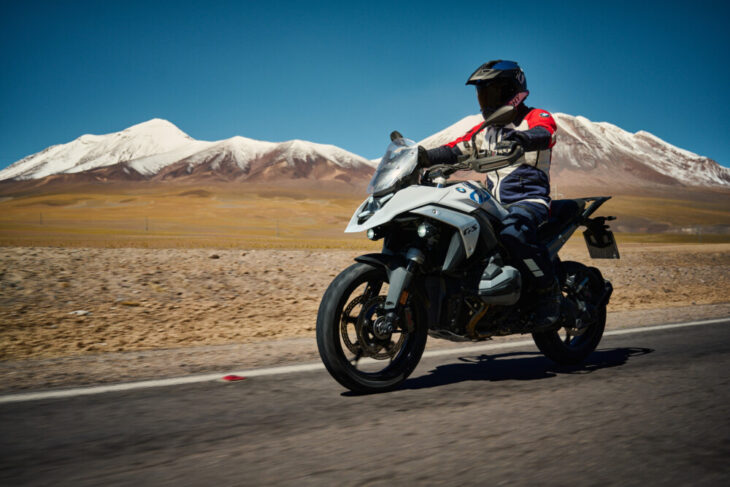 The front-end of the 1300 GS is a massive departure from the 1250’s.
The front-end of the 1300 GS is a massive departure from the 1250’s.
The 1300 also gets the new Adaptive Vehicle Height Control algorithm and sports suspension. The Adaptive Vehicle Height Control reduces the seat height from 33.5 inches to 32.3 inches at standstill and during slow travel, and the system can be customized, where the rider can choose between automatic or permanent lowering and the permanent high setting, depending on personal requirements.
With the Sports Suspension, the GS gains 0.8 inches more spring travel and a firmer set-up.
Braking gets the ABS Pro and Dynamic Brake Control as standard fitment and it’s also available with forged or cross-spoke wheels. The system applies both front and rear brakes at the same time, regardless of if you just grab/push on one lever or not. It depends on which riding mode you’re in as to the front/rear braking bias, but if you go into the ABS Pro settings, you’ll be able to lock the rear if you want to.
As a back-up system to BMW Motorrad Fully Integral ABS Pro, Dynamic Brake Control (DBC) offers increased safety when braking, by preventing unintentional throttle application. By means of intervention in the engine control, the drive torque is reduced during braking, making full use of the braking power at the rear wheel.
The rider triangle is easily customizable with a total of four available seat variants, three different footrests, 1.2-inch taller Comfort handlebars, and different hand and foot levers.
Moving onto the face, gone are the odd-shaped headlights that have been a GS trademark for decades. The new X-shaped LED headlight contains an optional cornering light function (Headlight Pro) as well as high and low beam in the one unit.
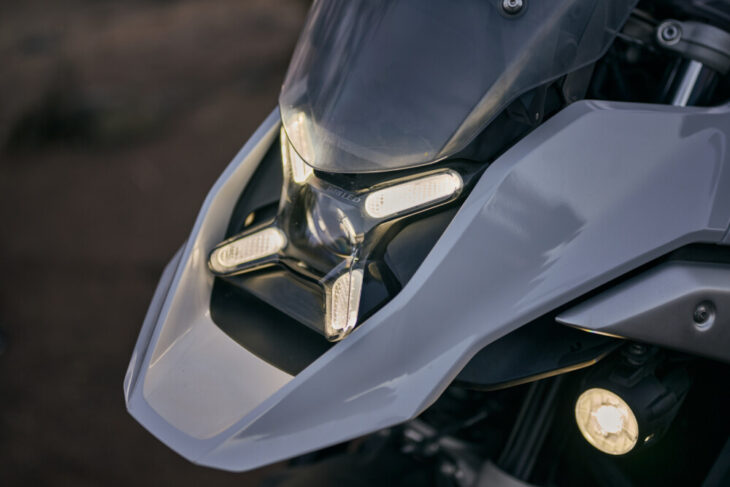 New all in one headlight has the high and low beam together.
New all in one headlight has the high and low beam together.
The electronics also include the new radar-assisted Active Cruise Control (ACC), Front Collision Warning (FCW) and Lane Change Warning (SWW) systems. Pioneered by arch-rivals Ducati and KTM, the GS now joins them in the tech race and even overtakes them with the FCW system that gently applies the brakes if it detects an imminent crash (BTW, it won’t fully save you from a crash).
The radar cruise control works the same as those from Ducati and BMW’s R18 Transcontinental, which detects the distance to the car in front and holds the bike there, reducing the chance of a crash. Lane Change Warming will let you know if a car is in your blind spot by illuminating a corner of the rear vision mirror.
We’ll be testing the R 1300 GS from Spain next month, so stay tuned to see if the biggest revision yet to the iconic GS lives up to the hype.
BMW R 1300 GS Standard Equipment
- Ultimate Care break-in service included.
- 1300 cc air/liquid cooled boxer motor with BMW ShiftCam technology.
- 6-speed transmission with wet anti-hopping clutch and Cardan driveshaft.
- 6.5-inch TFT display with enhanced Connectivity.
- Heated grips.
- Keyless Ride (steering, ignition and fuel tank lock).
- Tire Pressure Monitor TPM.
- Dynamic Traction Control DTC.
- Engine Drag Torque Control MSR.
- Dynamic Brake Assist DBC.
- Hill Hold Control HSC.
- BMW Motorrad Full Integral ABS Pro.
- Cruise control DCC with brake function.
- Matrix LED Headlight
- Four Ride Modes
- LiO 12v battery with Battery Guard.
- 12v power socket.
- Hand protectors with integrated turn indicators.
- Smartphone charging compartment with integrated USB-A socket.
- Intelligent Emergency Call.
2024 BMW R 1300 GS Specification
| MSRP: |
Starting at $18,895 |
| Engine: |
ALiquid-cooled, twin-cylinder boxer |
| Displacement: |
1300cc |
| Bore x stroke: |
106.5 x 73mm |
| Fuel injection: |
Electronic fuel injection system, 52 elliptical throttle bodies, Ride-by-Wire throttle |
| Compression ratio: |
13.3:1 |
| Exhaust: |
2-2-1 |
| Transmission: |
6-speed |
| Clutch: |
Hydraulically controlled slipper and self-servo wet multiplate clutch |
| Electronics: |
LED lighting, traction control, wheelie control, hill hold control, Cornering ABS, four ride modes, optional Ride Modes Pro, Tire Pressure Monitoring, radar-assisted cruise control, blind spot detection, front collision warning |
| Chassis: |
Steel, two-section with bolt-on cast aluminum subframe |
| Front suspension: |
Evo Telelever |
| Rear suspension: |
Evo Paralever |
| Front brake: |
Dual four-piston calipers, 310 mm discs, ABS |
| Rear brake: |
Twin-piston caliper, 285 mm disc, ABS |
| Front tire: |
120/70 R 19 |
| Rear tire: |
170/60 R17 |
| Steering head angle: |
63.8° |
| Trail: |
4.4 in. |
| Wheelbase: |
59.8 in. |
| Seat height: |
33.5 in. |
| Fuel capacity: |
5.0 gal. |
| Weight (curb): |
523 lb |